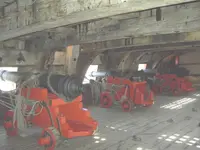- #1
Thread Owner
Hi all, I'm a long time lurker but first time poster. I'm particularly interested in Spanish and other wrecks from before the 18th century and one thing which has intrigued me is the number of instances in which only on half of a ship has been located and excavated, but the rest of the ship (usually the stern half) remains undiscovered. This has happened enough times that I got to wondering if perhaps the ships of this period somehow have a structural weakness which predisposes them to breaking in half. The other half must float off pretty far if it remains lost. It has happened in one particularly famous wreck here in Bermuda which would very likely contain a great amount of treasure if found.
My only theory is that perhaps the lost half has managed to get so thoroughly pounded on the reef that there's nothing left of it, but that seems unlikely as there would be at least artifacts remaining if not wood. But it seems equally unlikely that, once a wooden ship has broken in two, one half is able to float long enough to be carried by the wind and waves very far.
Does anyone have any insight into this? I've been trying to find as many resources on pre-19th century shipbuilding techniques as possible, but they really don't tell me much about survivability of a hull after it's been pounded to pieces on reefs.
Cheers
Dennis
My only theory is that perhaps the lost half has managed to get so thoroughly pounded on the reef that there's nothing left of it, but that seems unlikely as there would be at least artifacts remaining if not wood. But it seems equally unlikely that, once a wooden ship has broken in two, one half is able to float long enough to be carried by the wind and waves very far.
Does anyone have any insight into this? I've been trying to find as many resources on pre-19th century shipbuilding techniques as possible, but they really don't tell me much about survivability of a hull after it's been pounded to pieces on reefs.
Cheers
Dennis












